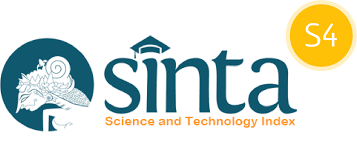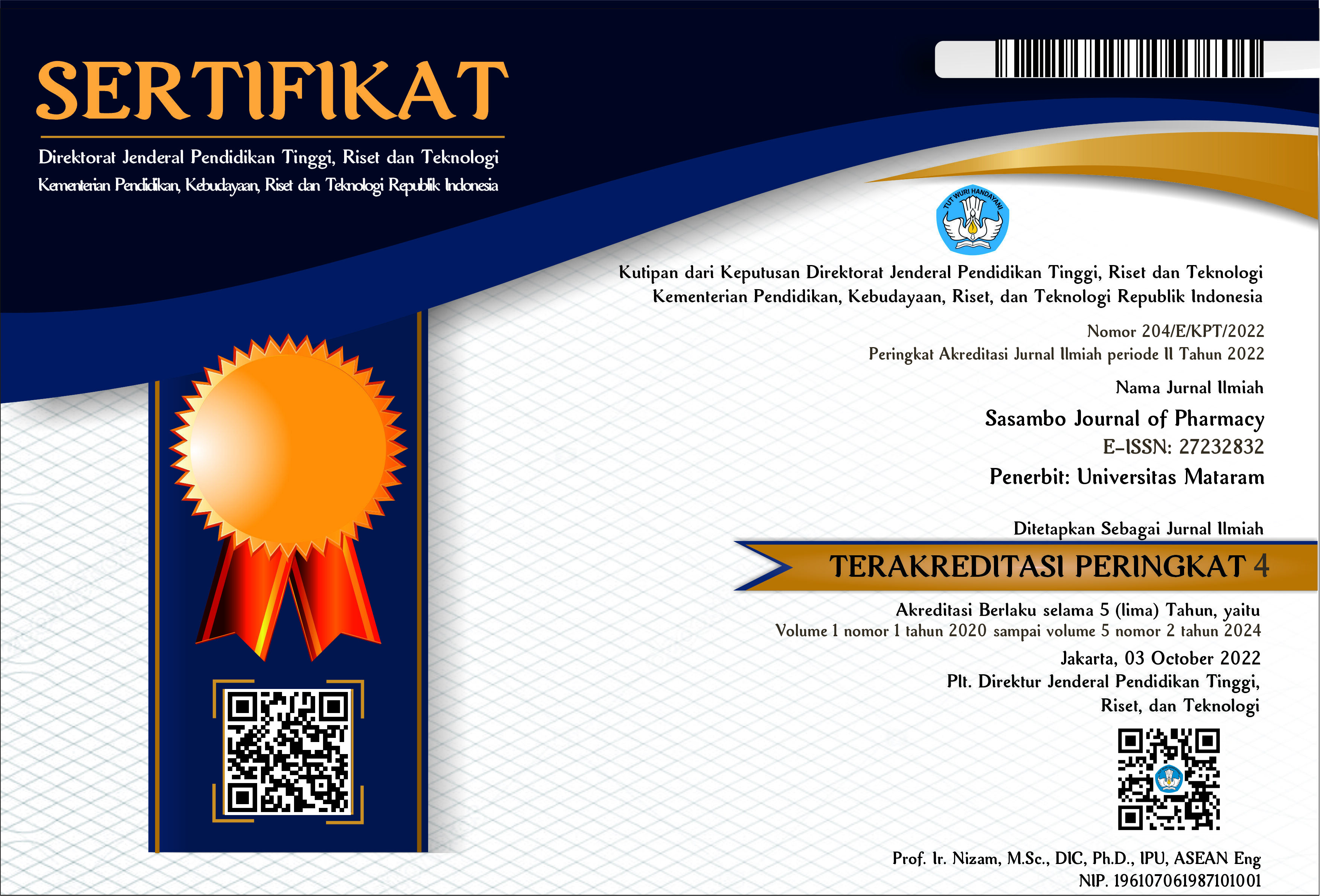Telaah: self-care mobile application untuk pencegahan luka diabetes
DOI:
10.29303/sjp.v6i2.624Downloads
Abstract
Self-care practices and appropriate glycemic management may prevent diabetic ulcer, a complication that has a detrimental effect on patients and their families. Through mobile-health applications, educational initiatives can increase patient awareness and promote the early preventative measures required to minimize complications from diabetes. The purpose of this review of the literature is to investigate research on the development of mobile-health applications for people with diabetes. The articles reviewed were obtained through keyword searches in the PubMed and Google Scholar databases within the last 10 years. According to seven published articles, six applications were created as self-care resources for people with diabetes mellitus. In order to prevent diabetic ulcer, mobile-health applications might assist people with diabetes maintain their independence in self-care routines.
Keywords:
Self-care, Mobile application, Prevention, Ulcer, Diabetes MellitusReferences
Agustini, N. L. P. I. B., Dewi, N. P. a. R., Putra, K. a. N., & Sanjana, W. E. (2025). Usability and functionality of M-DFEET application for the independence of foot care in diabetes mellitus patients. The Medical Journal of Malaysia, 80(2), 178–182.
Alavi, A., Sibbald, R. G., Mayer, D., Goodman, L., Botros, M., Armstrong, D. G., Woo, K., Boeni, T., Ayello, E. A., & Kirsner, R. S. (2014). Diabetic foot ulcers. Journal of the American Academy of Dermatology, 70(1), 1.e1-1.e18. https://doi.org/10.1016/j.jaad.2013.06.055
Almalki, Z. S., Ahmed, N. J., Alahmari, A. K., Alshehri, A. M., Alyahya, S. A., Alqahtani, A., & Alhajri, M. (2021). Identifying the Risk Factors and the Prevalence of Poor Glycemic Control among Diabetic Outpatients in a Rural Region in Saudi Arabia. Journal of Pharmaceutical Research International, 15–23. https://doi.org/10.9734/jpri/2021/v33i24A31427
Amin, N., & Doupis, J. (2016). Diabetic foot disease: From the evaluation of the “foot at risk” to the novel diabetic ulcer treatment modalities. World Journal of Diabetes, 7(7), 153. https://doi.org/10.4239/wjd.v7.i7.153
Balitbangkes, B. P. dan P. K. (2018). Riset Kesehatan Dasar 2018. Departemen Kesehatan, Republik Indonesia Jakarta.
Chen, H.-Y., Kuo, S., Su, P.-F., Wu, J.-S., & Ou, H.-T. (2020). Health Care Costs Associated With Macrovascular, Microvascular, and Metabolic Complications of Type 2 Diabetes Across Time: Estimates From a Population-Based Cohort of More Than 0.8 Million Individuals With Up to 15 Years of Follow-up. Diabetes Care, 43(8), 1732–1740. https://doi.org/10.2337/dc20-0072
De Macedo, G. M. C., Nunes, S., & Barreto, T. (2016). Skin disorders in diabetes mellitus: An epidemiology and physiopathology review. Diabetology & Metabolic Syndrome, 8(1), 63. https://doi.org/10.1186/s13098-016-0176-y
De Pablos‐Velasco, P., Parhofer, K. G., Bradley, C., Eschwège, E., Gönder-Frederick, L., Maheux, P., Wood, I., & Simon, D. (2014). Current level of glycaemic control and its associated factors in patients with type 2 diabetes across Europe: Data from the PANORAMA study. Clinical Endocrinology, 80(1), 47–56. https://doi.org/10.1111/cen.12119
Dincer, B., & Bahçecik, N. (2021). The effect of a mobile application on the foot care of individuals with type 2 diabetes: A randomised controlled study. Health Education Journal, 80(4), 425–437. https://doi.org/10.1177/0017896920981617
Haycocks, S., Cameron, R., Edge, M., Budd, J., & Chadwick, P. (2022). Implementation of a novel mHealth application for the management of people with diabetes and recently healed foot ulceration: A feasibility study. Digital Health, 8, 20552076221142103. https://doi.org/10.1177/20552076221142103
Kilic, M., & Karadağ, A. (2020). Developing and Evaluating a Mobile Foot Care Application for Persons With Diabetes Mellitus: A Randomized Pilot Study. Wound Management & Prevention, 66(10), 29–40.
Magliano, D. J., & Boyko, E. J. (2022). IDF diabetes atlas.
Marques, A. D. B., Moreira, T. M. M., Carvalho, R. E. F. L. de, Chaves, E. M. C., Oliveira, S. K. P. de, Felipe, G. F., & Silveira, J. A. N. da. (2021). PEDCARE: validation of a mobile application on diabetic foot self-care. Revista Brasileira de Enfermagem, 74(suppl 5), e20200856.
Marques, A. D. B., Moreira, T. M. M., Jorge, T. V., Rabelo, S. M. S., Carvalho, R. E. F. L. D., & Felipe, G. F. (2020). Usability of a mobile application on diabetic foot self-care. Revista Brasileira de Enfermagem, 73(4), e20180862. https://doi.org/10.1590/0034-7167-2018-0862
Ploderer, B., Brown, R., Seng, L. S. D., Lazzarini, P. A., & Van Netten, J. J. (2018). Promoting Self-Care of Diabetic Foot Ulcers Through a Mobile Phone App: User-Centered Design and Evaluation. JMIR Diabetes, 3(4), e10105. https://doi.org/10.2196/10105
Seité, S., Khemis, A., Rougier, A., & Ortonne, J. (2011). Importance of treatment of skin xerosis in diabetes. Journal of the European Academy of Dermatology and Venereology, 25(5), 607–609. https://doi.org/10.1111/j.1468-3083.2010.03807.x
Wallace, D., Perry, J., Yu, J., Mehta, J., Hunter, P., & Cross, K. M. (2019). Assessing the Need for Mobile Health (mHealth) in Monitoring the Diabetic Lower Extremity. JMIR mHealth and uHealth, 7(4), e11879. https://doi.org/10.2196/11879
Zhang, P., Lu, J., Jing, Y., Tang, S., Zhu, D., & Bi, Y. (2017). Global epidemiology of diabetic foot ulceration: A systematic review and meta-analysis. Annals of Medicine, 49(2), 106–116. https://doi.org/10.1080/07853890.2016.1231932
License
Copyright (c) 2025 The Author(s)

This work is licensed under a Creative Commons Attribution 4.0 International License.
Authors who publish with Sasambo Journal of Pharmacy (SJP), agree to the following terms:
- Authors retain copyright and grant the journal right of first publication with the work simultaneously licensed under a Lisensi Creative Commons Atribusi 4.0 Internasional. This license allows authors to use all articles, data sets, graphics and appendices in data mining applications, search engines, web sites, blogs, and other platforms by providing an appropriate reference. The journal allows the author(s) to hold the copyright without restrictions and will retain publishing rights without restrictions.
- Authors are able to enter into separate, additional contractual arrangements for the non-exclusive distribution of the journal's published version of the work (e.g., post it to an institutional repository or publish it in a book), with an acknowledgment of its initial publication in Sasambo Journal of Pharmacy
- Authors are permitted and encouraged to post their work online (e.g., in institutional repositories or on their website) prior to and during the submission process, as it can lead to productive exchanges, as well as earlier and greater citation of published work (See The Effect of Open Access).







